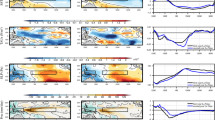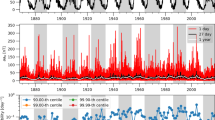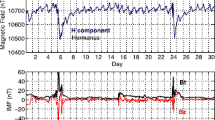Abstract
In this paper geomagnetic disturbances at middle and low latitudes are discussed by using geomagnetic data of the magnetic storm of 15–16 July 2000. This storm is a response to the solar Bastille Day flare on 14 July. Generally, the geomagnetic disturbances at middle and low latitudes during a storm are mainly caused by three magnetospheric–ionospheric current systems, such as the ring current system (RC), the partial ring current and its associated region II field-aligned currents (PR), and the region I field-aligned currents (FA). Our results show that: (1) The northward turning of IMF-Bz started the sudden commencement of the storm, and its southward turning caused the main phase of the storm. (2) The PR- and FA-currents varied violently in the main phase. In general, the field of the FA-current was stronger than that of the PR-current. (3) In the first stage of the recovery phase, the RC-field gradually turned anti-parallel to the geomagnetic axis from a 15° deviation, and the local time (Λ) pointed by the RC-field stayed at 16:00. After that, Λ rotated with the stations, and the RC-field was not anti-parallel to the geomagnetic axis, but 5°–10° deviated. These facts suggest that the warped tailward part of the ring current decays faster than the symmetric ring current.
Similar content being viewed by others
References
Akasofu, S.-I. and Chapman, S.: 1964, Planetary Space Sci. 12, 607.
Alexeev, I. I., Belenkaya, E. S., Kalegaev, V. V., Feldstein, Y. I., and Grafe, A.: 1996, J. Geophys. Res. 101, 7737.
Cahill Jr., L. J. and Winckler, J. R.: 1999, J. Geophys. Res. 104, 12229.
Chapman, S. and Bartels, J.: 1940, Geomagnetism, Oxford University Press, Oxford.
Chen, H.-F. and Xu, W.-Y.: 2001, Chinese J. Geophys. 44, 491.
Compbell, W. H.: 1973, J. Atmospheric Terrest. Phys. 35, 1127.
Compbell, W. H.: 1996, Eos Trans. AGU 77, 283.
Crooker, N. U. and McPherron, R. L.: 1972, J. Geophys. Res. 77, 773.
Cummings, W. D. and Coleman Jr., P. J.: 1968, J. Geophys. Res. 73, 5699.
Fukushima, N. and Kamide, Y.: 1973, Rev. Geophys. 11, 795.
Iyemori, T.: 1990, J. Geomagn. Geoelectr. 42, 1249.
Kamide, Y. and Fukushima, N.: 1971, Rep. Ion. Space Res. Japan, 25, 125.
Kamide, Y. and Fukushima, N.: 1972, Rep. Ion. Space Res. Japan, 26, 79.
Meng, C.-I. and Akasofu, S.-I.: 1967, J. Geophys. Res. 72, 4905.
Opp, A. G.: 1968, J. Geophys. Res. 73, 5697.
Rufenach, C. L., Martin Jr., R. F., and Sauer, H. H.: 1989, J. Geophys. Res. 94, 15125.
Russell, C. T.: 1986, Geophys. Res. Lett. 3, 593.
Shue, J.-H., Song, P., Russell, C. T., Chao, J. K., and Yang, Y. H.: 2000, J. Geophys. Res. 105, 2641.
Williams, D. J.: 1983, Space Sci. Rev. 34, 223.
Williams, D. J.: 1985, Space Sci. Rev. 42, 376.
Xu, W.-Y.: 1992, Acta Geophysica Sinica, 35,1.
Author information
Authors and Affiliations
Rights and permissions
About this article
Cite this article
Chen, HF., Xu, WY., Chen, GX. et al. Latitudinal characteristics of the geomagnetic field during the storm of 15–16 July 2000. Sol Phys 204, 339–349 (2001). https://doi.org/10.1023/A:1014287627914
Issue Date:
DOI: https://doi.org/10.1023/A:1014287627914




